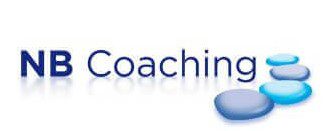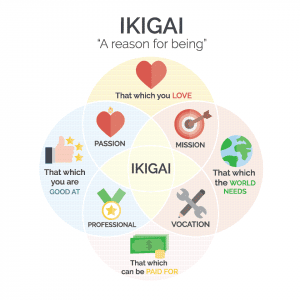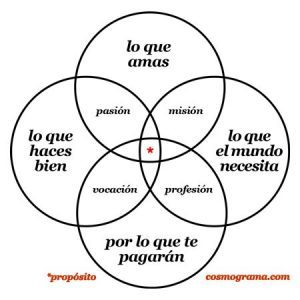We’ve all been there, trying to rush round the supermarket only to find you’ve picked the trolley with the wonky wheel!
No matter how hard you push, it just won’t go in the right direction.
Likewise, in life & business, if you don’t have balance, no matter how hard you work your progress can be slow & unrewarding.
If you feel rather frustrated with your progress right now and have been left wondering, why you went into business in the first place then maybe it’s time to consider your Ikigai. However, before you do that, I want to give you a bit of background to the tools we commonly refer to when exploring our Ikigai.
What is Ikigai?
Ikigai is generally thought of as the reason why you get up in the morning and many people will be familiar with the representation below.
However, this this Venn Diagram is actually an amalgamation of 2 different models or concepts.
- Ikigai- the Japanese philosophy for having a long and happy life
- And a venn diagram which was created to explore your life purpose
The diagram was originally developed by astrologer and author, Andrés Zuzunaga as a tool to uncover purpose. It uses the 4 areas of doing what you love, what you are good at, what the world needs and what you can be paid for as a way to focus down to find the intersection and common themes to form your life purpose.
Then we have Ikigai which is a Japanese philosophy of lifestyle choices which underpin a long and happy life.
Many of the popular books we are familiar with are based on interviews with communities of centenarians who live in Japan. When asked about Ikigai they refer to a sense of purpose, of the importance of community, a healthy lifestyle in terms of food and movement, being in the here and now and finding joy in the small things in life.
A blogger called Marc Winn then merged the 2 concepts into the diagram we see here.
I still think it has merits, particularly when we consider this from the perspective of a business or an entrepreneur, sometimes it’s called the Westernised Ikigai or Entrepreneur’s Ikigai.
I use it with many of my clients, who are all business owners, as it is often the imbalance or dissatisfaction in one area that is causing them frustration. Some feel they don’t spend enough time doing what they love as they are being pulled in all directions or perhaps they aren’t valuing their skills and time sufficiently so I do find it useful tool.
However, there are times when the combined model doesn’t work so well. Consider Mother Teresa, someone we would consider to have a very clear life purpose or Ikigai. She loved what she did, she was good it and definitely the world need it but she wasn’t paid, not financially,
Does that mean she wasn’t living by her life purpose or Ikigai? Clearly not.
If you do choose to use this model, and I would suggest that you do, I would ask you to be aware of this mixing of concepts and to be mindful that in some circumstances, “ Being Paid” may refer to other rewards rather than just financial. I also want you to keep in mind the overarching, broader principle of Ikigai which will influence all 4 areas too.
Aikihiro Hasegawa defines Ikigai as ‘a sense of being alive now, an individual’s consciousness as a motive to live.’
Daily choices which influence all aspects of our life –
- Community and Connection
- Healthy lifestyle in terms of food and movement
- Being in the here and now
- Joy in small things
- Starting Small
- Harmony and Sustainability
If you would like to discuss your own Personal Ikigai, I’m happy to chat this through with you, please feel free to book a call or just message me with your comments or questions.



